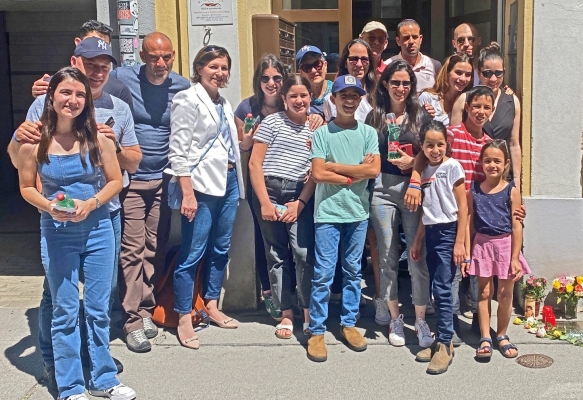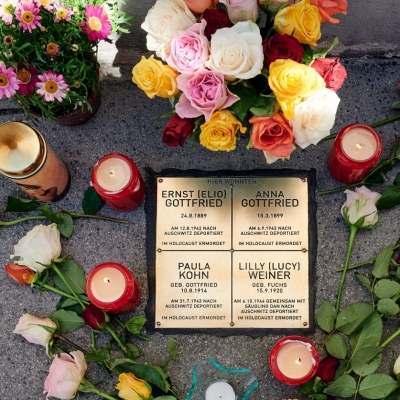Memorial Stones – Vienna 2022
"As long as we remember a person, they're not really gone. Their thoughts, their feelings, their memories, they become part of us"
Justin Cronin, The Twelve (The Passage #2)
My wife, Celia, was reading the novel Sarah's Key by Tatiana De Rosnay. She finished it in a day. The story begins in Paris during World War II, when the French police were rounding up Jews, sending them to the Drancy detention camp and then to Auschwitz. My paternal grandfather had been in Drancy, so I was intrigued and read the book. Little did I know that Sarah's Key was going to unlock the story of my family's fate during the Shoah, and lead to an emotionally unforgettable journey to Vienna.
Thus began a period of research. My brother and I knew that our father, Ben, had fled Vienna shortly after the German annexation of Austria (Anschluss). He reached England and did not personally experience the full horror of the Shoah. Most of his family had also fled Vienna, finding refuge in Belgium where our father saw them when he went there on his honeymoon. War broke out one week after his return to London. He never saw his family again.
Neither my brother nor I had ever asked our father about his life in Austria. While he was not against talking about it, he rarely initiated the subject. Although our father was still alive when I began my research, his memory was not completely reliable. I had to depend almost entirely on what I could discover myself. I began unlocking a world of family about whom I knew little or nothing at all.
I learned of the harrowing journey of my father's father, Elio, who was deported from Brussels to southern France when the Germans invaded Belgium. He was interned in St. Cyprien detention camp and later, Camp Gurs. The conditions at these camps were primitive at best; death and disease were ever-present. In 1942 Elio was transported to Drancy, which was under the control of the French police. After two days he was sent to Auschwitz. His fate there is unknown, although some evidence points to the possibility that he may have been selected for slave labor at the sub-camp of Jawischowitz. He did not survive.
My father's sister, Paula, had escaped to Antwerp together with her husband and year-old son. The son was given to a Catholic family for safekeeping. In 1943 Paula was sent to Dossin Barracks in Malines, and then to Auschwitz. Dossin was a detention and deportation camp run by mostly German staff, assisted by Belgian paramilitaries. I discovered that the train taking Paula to Auschwitz had a breakout. I did not find a record of her having arrived at the camp. How she met her fate remains unknown. Perhaps she was shot trying to escape. As for her son, he stayed with the Catholic family after the war, with his father's approval.
I did not know of the existence of my father's aunt Sophie, her husband Ira and their daughter, Lilly, all of whom were unable to escape Vienna before the gates closed. My father himself would not have been aware that his cousin, Lilly, married Oskar Weiner in 1941 and gave birth to a son, Dan in 1942. He would not have had the details of their murder. Ira and Sophie were killed in Belzec. Lily, Oskar and Dan were sent to Theresienstadt. Then mother and infant son were sent to Auschwitz where they perished. Oskar was sent from Theresienstadt to Dachau; where he died shortly before its liberation.
My father was born in 1916 in the apartment of his maternal grandmother, Dvora. His own father was, at that time, in the Austrian army. The Nazis later used the building in which the apartment was situated as a collection point prior to transporting Jews to the east and their fate. Dvora was 67 years old when the Anschluss happened. She escaped to Brussels together with her daughter Feige, son-in-law Max, and their daughter Irma. In 1942 they were arrested by the Nazis sent to the Dossin Barracks and then to Auschwitz where they were murdered. I knew none of these facts until I began my research.
Obviously, acquiring all this information had a strong emotional effect on me. It motivated my wife and I to contact the organization responsible for laying memorial stones. As a result, in June 2022, we travelled to Vienna, to consecrate Memorial Stones (Steine der Erinnerung) outside the apartment buildings for nine of my father's family who were murdered in the Shoah. We went with our children, their partners and their children. We were also joined by my brother and sister-in-law.
At Ben Gurion airport prior to departure, my children handed out bracelets that they had had made. Written on these were the names of murdered family members and the words of the Ehud Manor song as sung by Ofra Haza. These words became the theme of our journey to Vienna – שמעו אחי אני עוד חי (Listen my brothers, I'm still alive).
Our time in Vienna began with a visit to Ostarrichi Park. In the park is a circular memorial wall on which the names of more than 64,000 Austrian Jews murdered by the Nazis are listed. We searched for and found the names of all our family members. The memorial, in a busy part of Vienna where life is continuing normally, evoked in me echoes and shadows of darker times. I recalled my father's stories of how, after the Anschluss, Vienna changed overnight. Shops and establishments, that he had frequented, were now out of bounds to Jews. I once heard someone say that the Austrians were worse soldiers than the Germans; but they were better Nazis.
The commemoration ceremony began at 10:00, in a small square located outside the second district (Leopoldstadt), in the presence of members of the families from around the world who were consecrating memorial stones. Leopoldstadt was, and is once again, becoming the Jewish area of Vienna. In 1938, about 200,000 Jews had lived in Vienna, approximately 10% of Vienna's total population. The vast majority lived in Leopoldstadt. It was known as the Mazzeinsel (Matzah Island).
After light entertainment, speeches from the organizers and the district alderman; our procession began. At each stone, the procession stopped and people spoke at the site of their families' apartments. The plaques commemorating my family members were situated at Kleinepfargasse 7, where my father had lived together with his father's family, and at Malzgasse 14, where my father was born and his mother's family lived. My father's grandmother, Dvora, owned a grocery that was overlooked by a Jewish orphanage where my mother lived. My father used to deliver groceries to the orphanage and it was there that he saw and fell in love with my mother.
In an amazing gesture one of the residents (non-Jewish) of the building where my father had lived, after learning about the upcoming ceremony, had contacted the organizers. She asked whether it would be appropriate to place flowers and candles around the stones. She also offered to clean and maintain them.Naturally, we agreed and invited her to be at the ceremony. Her presence together with her daughters, added another dimension to the event.
Another emotional moment for us was when we passed close to the fateful corner where my father, shortly after the Anschluss, was on his way to visit his wife to be. He had been stopped by an elderly woman who asked if he was Jewish. When he replied in the affirmative, she told him not to continue. Peeking around the corner, he saw Nazi brown-shirts checking pedestrians' papers and loading some of them onto a truck. My father later found out that those people had been arrested, interrogated and that some of them were sent to Dachau.
We felt my father's presence, not only during the ceremonies outside the apartments, but also in the Stadttempel Synagogue which we attended on Shabbat. He had sung there as a child in the choir.









Comments